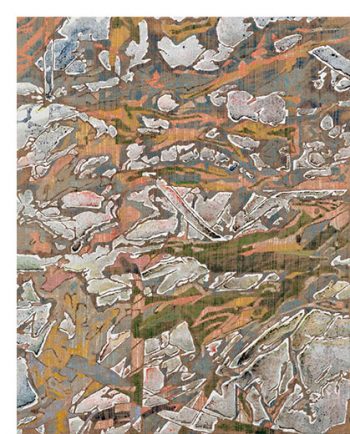by Mark Van Proyen

Atop the passages of thickened gesso are a variety of other paint applications that seem as if they were the visible fragments of an unseen whole. Certain areas sport highlights and drop shadows that make it appear as if collage elements were affixed to the works’ surfaces, conjuring the 1950s decollage works of Mimmo Rotella or, more generally, the underlying layers of billboards that have been exposed by heavy rain. Layers upon layers, you might say, but they do coalesce into configurations that represent things both larger and smaller than themselves, drawing multiple parallels between microcosm and macrocosm. For example, in the 2017 painting titled Ghost Rider, we see a knot of shapes that seem to be more than accidentally related to Jackson Pollock's post-1944 drip paintings, while the largest work in the exhibition, Vortex (2018), at 114 x 74 inches, simultaneously evokes the swirling configurations of fingerprints and satellite images of weather patterns — all rendered as a sparkling, pulsating surface. Force of Nature II (2019) shows the intricate circuitry of a computer chip hovering as part of a more complex configuration, while Torn (2018) sports shapes that resemble the
Looking at the 16 works in this exhibition, it’s hard not to notice that Haeckel has a repertory of about 20 moves that she makes use of, although in any given work, she may only limit herself to six or seven. This self-imposed limitation is particularly evident in several multi-panel works where the individual sections seem unalike, a characteristic most apparent in the five-panel work Dead Water (2018), which appears to be a set of variations on the theme of painterly layering. It displays a full catalog of Haeckel's more extensive vocabulary of painterly procedures.
It is worth noting that Haeckel lives and works in Dusseldorf, and for that reason, it might be natural to see her work as having some relation to that of Gerhard Richter, who casts a large shadow in Dusseldorf from having taught at the Kunstakadamie for 15 years. I have always thought that his work could be called "handmade digital painting" because of the way that his pigment applications glide and gloss over what they purport to represent, creating a distancing effect that seems like an aloof and disengaged treatment of troublesome historical subjects. Unless we read Haeckel’s paintings as having something to do with climate change (maybe, but not likely), the notion of their having any troublesome subject matter seems only a remote possibility. Thus, the impact of their polyvalent insistence on saturated surface complexity is the opposite of Richter's ominous glide-and-gloss gesturalism.
The idea of the surface of a painting as having something to do with metabolic filtration seems like an excellent way to account for the liveliness of Haeckel's pictures, which reveal themselves as interlaced accretions of multiple energy systems.
The surfaces of Haeckel's paintings obstinately insist on being understood as a coalesced palimpsest of improbabilities that point toward hidden horizons large and small. Because of this, comparisons to Albert Oehlen, who also taught at the Kunstakadamie for many years, seem more reasonable. Oehlen's works usually feature hypercomplex, multi-layered surfaces formulated out of intricate webs of brushstrokes. Haeckel’s paintings deviate sharply from such an emphasis on the implicitly phallic brushstroke, so much so that we might be tempted to see them as exemplifications of what Barbara Claire Freeman called The Feminine Sublime: “…the roar that lies within silence…that contests any notion of essence.”1 This model celebrates how women manage and distribute fluids and their attendant emotions differently than men, leading 
This idea of the surface of a painting as having something to do with metabolic filtration seems like an excellent way to account for the liveliness of Haeckel's pictures, which reveal themselves as interlaced accretions of multiple energy systems. Prompting this reading are a collection of Japanese stones set about the gallery; they were salvaged from old buildings dating from the Edo and Kamakura periods (c. 1185 to 1868). In the context of this exhibition, these objects evoke a slowing down of perception that is in keeping with Zen mindfulness, which is the preferred state of mind while looking at Haeckel's work. Moreover, the surfaces of these objects are in themselves surprisingly lively, encrusted by the patinas of time and also sporting areas inhabited by rich ecosystems of lichen, some ancient, others still alive. As the Zen sages are fond of saying, all of nature is alive, and we might well say the same about Haeckel's paintings.
# # #
Jutta Haeckel: “Double Nature” @ Hosfelt Gallery through November 27, 2019.
About the author:
Mark Van Proyen’s visual work and written commentaries focus on satirizing the tragic consequences of blind faith placed in economies of narcissistic reward. Since 2003, he has been a corresponding editor for Art in America. His recent publications include: Facing Innocence: The Art of Gottfried Helnwein (2011) and Cirian Logic and the Painting of Preconstruction (2010). To learn more about Mark Van Proyen, read Alex Mak's December 9, 2014 interview, published on Broke-Ass Stuart's website.
Notes:
1. Barbara Claire Freeman, The Feminine Sublime: Gender and Excess in Woman’s Fiction (University of California Press, 1995).
2. See Didier Anzieu, The Skin Ego (Yale University Press, 1988).